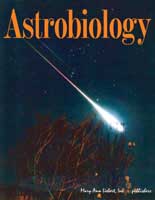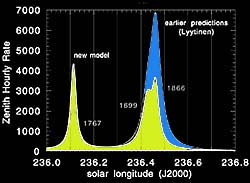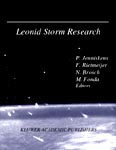|
Leonid MAC |
| home |
| View the shower |
| Mission Brief |
| Science Update |
| Media Brief |
| links |
|
Brief summary of
recent results of Leonid MAC research.
Leonid news2004:
SPECIAL ISSUE ASTROBIOLOGY
Read more:
JUNE BOOTID OUTBURST OBSERVED An outburst of June Bootid meteors was observed from about June 22 19h UT until June 24 01h UT (ZHR > 1/hr), peaking at a rate of ZHR ~ 30/hr at 11ÿý2 h UT, 2004 June 23.
Read more:
2003: QUADRANTID PARENT OBSERVED AT ESO The minor planet 2003 EH_1 was recovered with the New Technology Telescope at the European Southern Observatory on Christmas Eve. The object had not been seen since May. The new observations refine the orbit by a factor of about 100.
Read more:
QUADRANTID PARENT BODY DISCOVERED The Quadrantids are the most intense annual shower, but also the only major shower without a known parent body. Now, the parent is identified as 2003 EH_1, a minor planet first seen by the Lowell Observatory Near-Earth Search on March 06, 2003.
Read more:
Several very old dust trails had been predicted to be in Earth's path during the 2003 Leonid return, but clouds hampered most observing efforts. Read more: Nov 20 - Leonids hampered by clouds. 2002: SHOCK CONFIRMED New high-frame rate images confirm the presence of a shock in the images of bright Leonids.
Read more:
NEW MOLECULAR BAND DETECTED Nice new spectroscopic data on meteors and their afterglow contain emission from a new molecular band.
Read more:
LEONIDS TRACKED A small camera was succesfully pointed rapidly at meteors from the DC-8 aircraft, capturing the image of a bright -8 magnitude fireball.
Read more:
ASTEROIDS NAMED AFTER LEONID MAC PARTICIPANTS Two asteroids were named after Leonid MAC organizers by the International Astronomical Union.
Read more:
LEONID STORMS RICH IN FAINT METEORS The 2002 Leonid storms returned much as predicted, but were surprisingly rich in faint meteors. Best viewing was from aircraft.
Read more:
COLLECTING METEORIC DEBRIS FROM SNOW COVER Leonid meteoric debris can possibly be collected from snow fall in Antarctica and Greenland. The micro meteorites are recovered by melting the snow layer by layer, thus collecting meteoric debris from specific years.
Read more:
COSPAR/WORLD SPACE CONGRESS HIGHLIGHTS A special session on "Meteor Induced Chemistry, Ablation Products, and Dust in the Middle and Upper Atmosphere" was organized as a joint COSPAR/IAC event at the World Space Congress in Houston, TX, on October 16, 2002.
Read more:
FIRST UV SPECTRUM: LEONID FROM SPACE For the first time, a spectrum of a meteor was recorded in the ultraviolet, showing strong emission lines of ionized and neutral magnesium. It is found that the ionized line is a unique probe of the ionization conditions in the warm meteor plasma.
Read more:
2001:
GOOD PROSPECTS FOR NOVEMBER 2002 The interpretation of the meteor showers in terms of the dust trails of comet 55P/Tempel-Tuttle has come of age. Guest speaker Dr. Yoshihide Kozai of Gunma Astronomical Observatory of Japan post-predicted a possible dust trail encounter in 1990 from recent dust trail modeling. Regarding the 2001 Leonid storm over Asia, Toshifumi Yanagisawa of the National Aerospace Laboratory of Japan reported on observations of meteor trails near the radiant that make it possible to separate the 1866 dust trail from older 1699 ejecta of comet 55P/Tempel-Tuttle.
Read more:
SPECTACULAR BURST OF METEORS During the 2001 Leonid storm, as many as 1400 highschool children participated in an internet-based effort to gather flux measurements that map the spatial distribution of dust accross Japan in high detail. Organiser Dr. Bunji Suzuki reported possible filamentary structure in the shower over large spatial scales. Dr. Jun-ichi Watanabe of the National Optical Observatory of Japan reported several detections of meteoroids that had fallen appart recently in the interplanetary medium, creating spectacular local bursts of 15-40 meteors in just 2 seconds. Similar fragmentation processes may be responsible for pairing in meteors reported by Juraj Toth of the Copernicus University of Bratislava in Slovenia from an analysis of observations from the 1999 Leonid MAC mission. THE COMET GAS PRODUCTION RATE The meteor shower observations provide very accurate measurements of the dust ejected by the comet in each return. At the workshop it was reported that emissions from C2, NH2, and 630 nm OI line emission were observed in the comet atmosphere during the 1998 return by Toshihiko Hamane of Gunma Astronomical Observatory and colleages. A gas production rate of 320,000 g per second was derived for the time of the observations. NEW METEOR EMISSION MECHANISM DISCOVERED Dr. Jiri Borovicka of Ondrejov Observatory reported the discovery of recombination line emission in spectra of bright Leonid fireballs. This phase of the meteor's light decay followed directly on the afterglow that was discovered in the 1999 Leonid MAC mission. Spectacular spectra of this recombination emission were obtained as well by Japanese amateur astronomer Suzuki.
Read more:
OH EMISSION IN METEORS DISCOVERED Dr. Shinsuke Abe and coworkers of ISAS reported the detection of emission at 310 nm, of what appears to be the A-X OH emission. This emission points at the presence of water in the meteoroid or in the ambient atmosphere. STRONG LOWER LIMIT ON CN PRODUCTION Dr. Peter Jenniskens and Dr. Rick Rairden of Lockheed Palo ALto reported very strong upper limits to the production of the CN radical, expected from the decomposition of organic matter in the meteor, bringing down by a factor of 10 the amount of CN that is produced. Those limits strongly raise the likelyhood that meteors may have contributed organic matter to the early Earth at the time of the origin of life.
Read more:
RADAR REFLECTION SIGNATURE CHANGE Dr. Nakamura of the MU Radar facility in Kyoto, Japan, reported the first simultaneous observations of optical meteors and radar reflections. It was found that many echoes had a rapid decline in intensity halfway through the meteor's path. This is interpreted as a result of changing reflection conditions. HIGH FRAMERATE IMAGES SHOW UNEXPLAINED SHOCK Dr. Hans Stenbeak Nielsen of the University of Alaska at Fairbanks reported on further analysis of the high framerate images of Leonid meteors. The position of what looks like a shock has now been identified, but we are far from understanding the spectacular features in the meteor images.
Read more:
LEONID SHOWER UNEXPECTEDLY GOOD FOR USA OBSERVERS Analysis of 2000 Leonid shower observations by Peter Jenniskens of the SETI Institute at NASA Ames Research Center confirm earlier suspicions that the pattern of dust trails is slightly shifted towards the Sun compared to calculations by Esko Lyytinen and David Asher. This is good news for observers in Northern America, because peak rates are now predicted to be the same as during the 1999 Leonid storm at ZHR = 4,200 per hour. Observers in the western Pacific and Australia will not be disappointed either. The predicted peak rates are nearly as strong (ZHR = 3,700 per hour) and the trails are slightly wider, making these 1699- and 1866-dust trail encounters combined the more rich display by about 60 percent. Full paper. METEORS AND THE ORIGIN OF LIFE ON EARTH In a paper submitted to the proceedings of the 2001 Meteoroids conference in Kiruna, Sweden, Peter Jenniskens gives a review of recent studies on the fate of organic matter in meteors. Full paper. 2000:
URSIDS: DUST FROM TIME OF COLUMBUS ABOUT TO HIT EARTH ON DECEMBER 22, 2000 Dec. 18 - Dec 22 Ursid outburst
TWIN SHOWERS DURING UPCOMING 2000 LEONID ENCOUNTER New modeling predict that not one, but two sharply peaked Leonid showers will be visible in the nights of November 16/17 and 17/18, when Earth passes by the dust trails produced in the 1932 and 1866 returns of parent comet 55P/Tempel-Tuttle. Models suggest that the second night will be the better one, but analysis of last year's flux measurements onboard the Leonid MAC seem to indicate that the pattern is slightly shifted and the first night may be the better one. Rates can go up to Perseid shower levels or higher, with best viewing over the eastern USA at about 7:50 UT (2:50 EST). Californian observers can catch a glimpse of it around midnight. A tool is on the net that people can use to see how much activity is expected from their observing location. LIFE's PRECURSORS CAN SURVIVE PLUNGE IN ATMOSPHERE Not all meteoric matter is atomized during the plunge in Earth's atmosphere. Organic matter remained mysteriously undedected during last year's Leonid MAC. In a recent paper, Jenniskens et al. postulated that the organic matter may be lost in the form of large complex molecules that can readily emit the heat deposited by the violent collisions with air molecules before falling appart altogether. Such large molecules are not easily detected, except by their heat emission. Indeed, Ray Russell et al. discovered the fingerprint of organic matter in what may be meteoric debris in the path of a bright Leonid fireball. Pointing the mid-IR telescope onboard FISTA to the persistent train of the fireball, emission at 3.4 micron was detected that resembles the signature of complex organic matter observed in cometary dust. However, at present it can not be excluded that trace air compounds are responsible.
Read more:
METEOR SHOWER FROM SPACE Spectacular images of a meteor shower from space were released with the publication of a special issue of Earth, Moon and Planets. The images are a composite of numeous Leonid fireballs as seen from the MSX satellite near the limb of the Earth. Read more:
METEOR TRAINS REVEIL SECRETS Fast meteors that are bright enough leave persistent trains in the sky that are an eary trace of the brilliance of the meteor. "Glowworms" doubht by some, these trains have long kept their secret of why the glow persists for such a long time. Now, during Leonid MAC the light of such trains was unraveled (work by Borovicka and Jenniskens), reveiling an orange continuum emission band. Comparisson with laboratory measurements by John Plane (Univ. East Anglia) shows that iron oxide emission is responsible for the broad band emission, while sodium emission is detected too. Sodium and iron atoms catalyse the recombination of oxygen atoms and ambient ozone molecules back into molecular oxygen, being excited in the process. A similar chemistry is responsible for the airglow that is seen on the limb of the Earth. The trains can thus probe this important chemistry under unusual conditions.
Read more:
DEBRIS DETECTED IN AFTERGLOW OF FIREBALL For the first time, solid meteoric debris was detected in the afterglow of a bright Leonid fireball by Borovicka et al. A continuum black body emission betrayed this long sought after evidence that meteors do not totally obliterate when entering the Earth's atmosphere. The matter appeared to continue ablation at T ~ 1,400 K, and descended to lower altitude after it was deposited, when it was detected as a glowing emission in the path of the meteor. Numerous neutral atom emission were observed also, from which a rapid cooling was measured from about 4,500 K to 1,200 K in two seconds. Until now, meteoric debris was known only from asteroid-type fireballs that penetrated deep into the atmosphere. Now, for the first time, debris was observed of cometary matter. The high speed of the meteor makes it surprising that any matter at all could survive the plunge in Earth's atmosphere.
Read more:
Meteors not has hot as thought before. The first temperature measurements from the blazing light of Leonid meteors by Jenniskens et al. show that most of the visible light of meteors comes from a rather cool wake behind the meteoroid's head. At 4,300 K, that wake is not as hot as thought before and has just the right temperature for the chemical breakup of C-O, leading to potentially interesting organic chemistry in Earth's early atmosphere.
Read more:
METEORS SPROUT TINY OFFSPRING During last year's Leonid campaign it was discoved that Leonid meteors sprout mysterious jets of light in all directions when they come blazing into the Earth's atmosphere. Now, Mike Taylor et al. onboard Leonid MAC was able to prove that these jets are caused by small meteoroid fragments that are ejected with stupendous speeds, up to 2 km/s, from a tumbling mass of fragments caused by the evaporation of a "glue" that keeps the meteoroid together in space. Earlier detections in the 1998 Leonid MAC were made in white light. By using narrow band imaging, Taylor looked specifically for light from the meteoric magnesium, and found those jets of light to be even more prominent, proving that the jets are caused by small fragments of meteoric matter.
Read more:
ATMOSPHERE GETS A JOLT FROM LEONID STORM Joe Kristl et al. report an increase in OH airglow emission during the peak of the Leonid shower. No such change was observed for sodium emission and O2 airglow emissions. It is not clear yet how the enhanced influx of meteoric matter caused the change in airglow chemistry. Despois et al. observed a decline of HCN molecules in the upper atmosphere one day after the Leonid storm.
Read more:
METEORS EMIT LOW FREQUENCY RADIO WAVES A long standing controversie may finally have been settled. Numerous eye witnesses of bright fireballs in the past reported hissing and sissing sounds while watching the light of the meteor. Because it takes sound some time to travel from the meteor to the observer, it was long thought that meteors may emit low frequency radio waves that could induced audible sounds in nearby objects or the observers glasses, tooth fillings, etc. Now, Israeli observers Colin Price and Moshe Blum report the detection of ELF/VLF signals of unusual spectral character, peaking at the time of the 1999 Leonid meteor storm. It appears that even visible meteors produce detectable radio emissions. The signals are of unusually short duration (10 msec) and it is not clear yet how the signals are made.
Read more:
MORE STORIES Nov. 04 - Fear of heights?
DURING 1999 METEOR STORM, COMET DUST CRUMBLED LESS FINE Ian Murray et al. discovered from imaging onboard Leonid MAC that Leonids in the 1999 encounter fell appart in relatively larger fragments than did Leonids during the 1998 encounter. Both the 1998 and 1999 Leonid light curves were flat-topped, implying that the meteoroids quickly fell appart in fragments upon entry in the Earth's atmosphere, but the 1998 light curves tended to peak early in the trajectory followed by a gradual fading, while the 1999 light curves gradually ramped up to a late peak. The cause of this unexpected behaviour is not understood. Both encounters were with dust ejected in 1899. We now look forward to an encounter with the dust trail of 1932 on November 16/17, 2000.
read more:
| ||

 The journal Astrobiology has changed its traditional front cover to feature one of the spectacular fireballs photographed during the 2001 Leonid shower. This one is by Kris Asla from Aloha, Oregon. The issue features five papers that present results from the 2001 and 2002 Leonid MAC missions:
studies of the plasma temperature and temperature decay in the wake of meteors, and studies of CN, OH, and H emission that probe the exogenous delivery of organics and water.
The journal Astrobiology has changed its traditional front cover to feature one of the spectacular fireballs photographed during the 2001 Leonid shower. This one is by Kris Asla from Aloha, Oregon. The issue features five papers that present results from the 2001 and 2002 Leonid MAC missions:
studies of the plasma temperature and temperature decay in the wake of meteors, and studies of CN, OH, and H emission that probe the exogenous delivery of organics and water.

 LEONID STORM RESEARCH
Support the research: Order
directly from contributing Leonid MAC researchers your special issue
of the journal Earth Moon and Planets "Leonid Storm Research",
with over 40 articles on the 1998 and 1999 Leonid shower research
LEONID STORM RESEARCH
Support the research: Order
directly from contributing Leonid MAC researchers your special issue
of the journal Earth Moon and Planets "Leonid Storm Research",
with over 40 articles on the 1998 and 1999 Leonid shower research
